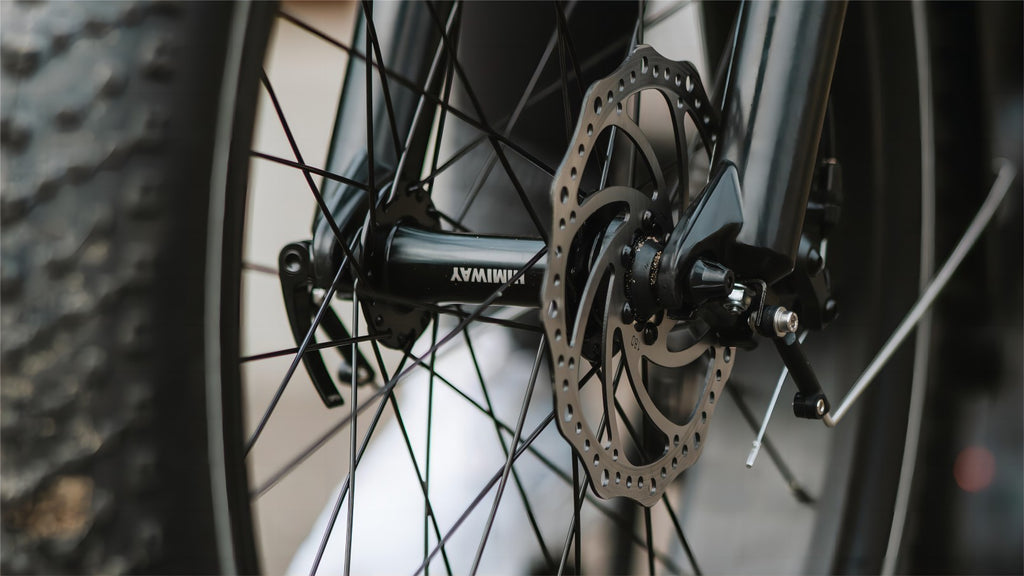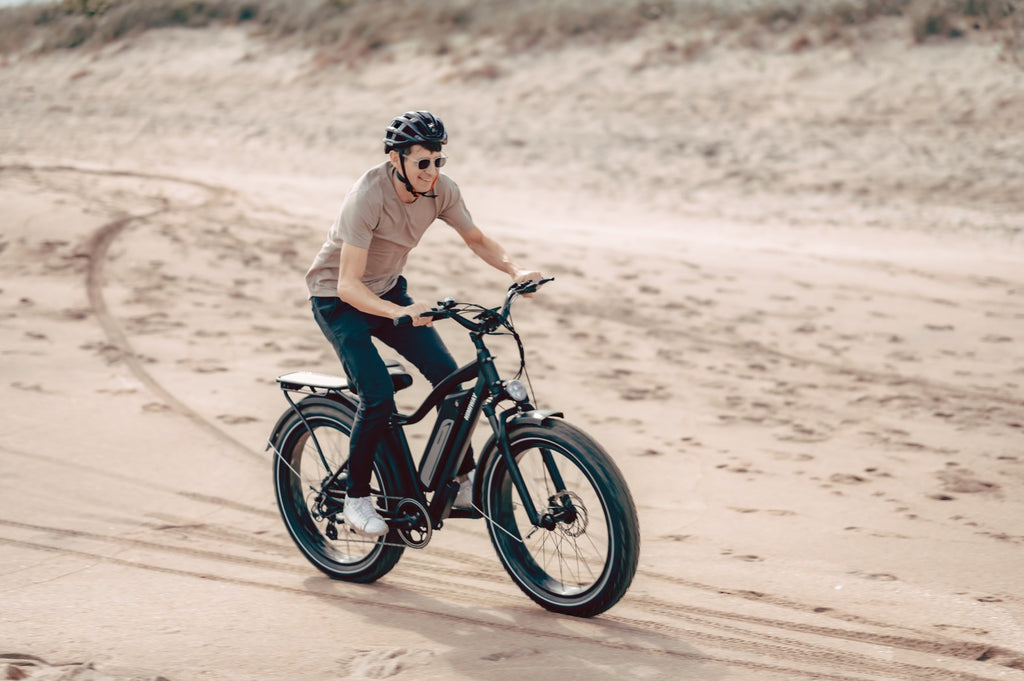Safety is paramount for every vehicle, and for cyclists, the brake’s performance should be one of your top checks when getting a new electric bike. The brakes on your electric bikes should be able to bring you to a smooth and prompt stop when encountering unexpected obstacles, traffic, or turns.
Electric bikes have higher speeds and increased weight than traditional bicycles, making reliable brakes essential to ensuring safety and control while riding your e-bike. It helps you stay in control, out of harm's way on the road, and avoid nerve-wracking experiences.
Himiway electric bikes have the most responsive brakes in the industry, but you don’t just have to take our word for it. Regardless of the type of brake you choose, hydraulic or mechanical disc brake, you can rest assured of its efficiency.
Why Is Braking Performance So Important for E-Bikes?

You might be wondering why braking performance matters so much for e-bikes. Well, with their higher speeds and increased weight, e-bikes require strong and responsive brakes to bring them to a stop safely. Reliable brakes capable of providing sufficient stopping power and control are vital in such situations. Proper braking performance ensures you can confidently navigate different riding conditions and enjoy a safer riding experience.
But it's not just stopping power. Your safety is also important. When you ride an e-bike, you're responsible for your well-being and others on the road. Reliable brakes protect you and allow you to respond to any potential dangers on the road, minimizing the risk of accidents and ensuring a safer riding experience.
Which Brakes for E-Bikes Are the Best?
Now, let's talk about the different types of brakes available for e-bikes and which ones are considered the best.
Mechanical Disc Brakes:
Mechanical disc brakes use a cable-actuated mechanism to engage the brake caliper when the brake lever is pulled. While they don't offer the same level of performance as hydraulic disc brakes, they still provide reliable stopping power and modulation. Mechanical disc brakes are typically more affordable than hydraulic ones and may require more frequent adjustments. Himiway’s Cruiser Long Range Fat Tire Electric Bike is equipped with powerful 180mm Mechanical Disc Brakes on both the front and rear to provide ample stopping power even in the harshest condition. This is a great choice for riders on a budget or those who prefer simpler brake systems.
Rim Brakes:
The classic brakes seen on non-electric bicycles are rim brakes, which include caliper brakes and V-brakes. They use friction pads that press against the wheel rim to slow or stop the bike. Rim brakes can be used on certain e-bikes, although they are rare due to the greater speeds and heavier weight of e-bikes. Rim brakes may provide enough stopping force for lighter, slower electric bikes, but they are less efficient in wet circumstances and may cause early wheel rim wear.
Regenerative Brakes:
Some e-bike systems have regenerative braking, which uses the motor to help slow the bike down. When you apply the brakes, the motor enters generator mode, turning the bike’s kinetic energy into electrical energy. This energy is then stored in the e-bike’s battery for subsequent use. Regenerative brakes can assist in extending the overall range of an e-bike while providing additional braking force. They are, however, often utilized as a backup braking system in conjunction with traditional brakes rather than as the primary stopping mechanism.
Hydraulic Disc Brakes:
Because of their great performance and dependability, hydraulic disc brakes are the preferred choice for e-bikes. A hydraulic system transmits the braking power from the brake lever to the brake caliper. Hydraulic disc brakes provide higher stopping force, accurate control, and good heat dissipation. Most Himiway electric bikes use hydraulic brakes, including the Himway Zebra Premium All-Terrain Electric Bike. These bikes require less maintenance and adjustment than other brakes, making them popular for e-bike riders looking for high-performance braking.
Best Choice: E-Bike Hydraulic Disc Brakes
Electric bike hydraulic disc brakes are designed with precision and efficiency in mind. These brakes have a fluid system that is pressurized and sealed from the outside. Releasing the lever changes the fluid pressure, pushing the brake pads to close onto the braking surface. This removes the work from your hands and lets the brake lever do all the work for you. This mechanism provides exceptional stopping power and control, especially in challenging riding conditions.
So, what makes hydraulic disc brakes the best choice for electric bikes?
Increased stopping power:
Hydraulic disc brakes offer superior stopping power, ensuring you can bring your e-bike to a quick and controlled stop when needed.
Better modulation:
These brakes provide precise control over braking force, allowing you to apply gradual or precise braking depending on the situation. This is particularly useful when navigating challenging terrains or making precise maneuvers.
Superior heat dissipation:
Hydraulic disc brakes dissipate heat generated during braking, ensuring consistent performance even during prolonged or intense rides. This helps prevent brake fade and maintains reliable stopping power.
Reduced maintenance:
Hydraulic disc brakes generally require less maintenance and adjustment than other brake types. They are self-adjusting, allowing you to spend more time riding and less time on brake maintenance.
Reliability:
Hydraulic disc brakes are known for their reliability and durability, making them dependable for e-bike riders seeking consistent and efficient braking performance.
What's the Difference Between Mechanical and Hydraulic Disc Brakes?
There are mentionable key factors to show the differences between mechanical and hydraulic disc brakes we should discuss. Mechanical disc brakes use a cable system to transfer the force from the brake lever to the brake caliper. On the other hand, hydraulic disc brakes utilize hydraulic fluid to transmit the force. While both types provide an improvement over traditional rim brakes, hydraulic disc brakes outshine mechanical disc brakes in several ways.
Hydraulic disc brakes offer smoother and more consistent braking performance. The hydraulic system eliminates cable stretch and provides better modulation, giving you more control over the braking force. Additionally, hydraulic disc brakes require less hand effort to apply the brakes, making them more user-friendly and reducing fatigue during long rides.
Features to Look for in E-Bike Brakes
When selecting e-bike brakes, you should consider the key features to ensure optimal performance and safety. One important feature is the motor cutoff switch – a crucial safety component in e-bike brakes. The motor cutoff switch automatically turns off the motor when the brakes are applied, preventing any unintended acceleration. It's important to ensure the motor cutoff switch is properly integrated and functioning to enhance rider control and overall safety.
Additionally, pay attention to the power and stopping capability of the brakes. Consider the riding type you plan to do and choose brakes that offer sufficient stopping power for your needs. Modulation and control are also essential features to look for, as they allow you to apply the brakes gradually and precisely, depending on the situation.
Heat dissipation and cooling are other important aspects to consider. Brakes that can handle heat well are less likely to experience brake fade, ensuring consistent performance even during long or intense rides.
Lastly, check the maintenance requirements and compatibility of the brakes with your e-bike system. Opt for brakes that are known for their durability and require minimal adjustments and maintenance.

How to Take Care of Your E-Bike Hydraulic Brakes
Taking care of your e-bike hydraulic brakes is essential to maintain optimal performance and ensure rider safety. Here are some tips for proper maintenance:
Keep Them Clean and Dry
Regularly clean your hydraulic brake components and keep them free from dirt, debris, and moisture. Use a soft brush or cloth to gently remove any buildup on the brake calipers, rotors, and pads. Cleaning your brakes not only improves their performance but also extends their lifespan.
Regularly Check E-Bike Brake Pads
Check your brake pads regularly to ensure they are in good condition. Look for any signs of wear or unevenness on the surface of the brake pads. If the pads have worn to a thickness of around 1-2 millimeters, it's time to replace them. Installing new brake pads will help maintain optimal braking performance and prevent damage to the rotor.
Bleed the Brakes When Needed
Bleeding your hydraulic brakes removes air bubbles and maintains proper brake fluid pressure. If you notice a spongy or less responsive feel when applying the brakes, it might be a sign that you need to bleed them. Bleeding brakes require specific tools and steps, so following the manufacturer's instructions or seeking professional assistance is recommended.
Inspect Pistons, Brake Hoses, Levers, and Screws
Regularly inspect various components of your hydraulic brakes, such as the pistons, brake hoses, levers, and screws. Look for any signs of damage, leaks, or loose fittings. If you notice any issues, it's important to address them promptly to maintain the integrity and performance of your brakes.
Top Tips for Correct Braking with an E-Bike
To ensure safe and effective braking with your e-bike, keep the following tips in mind:
1. Gradually apply the brakes instead of abruptly squeezing them to prevent skidding or losing control.2. Shift your body weight slightly backward during braking to increase rear tire traction and maintain stability.
3. Avoid excessive front brake usage, as it can cause the bike's rear to lift and potentially result in a dangerous flip over the handlebars.
4. Practice emergency braking in a controlled environment to improve your reflexes and better understand your e-bike's braking capabilities.
Conclusion
Prioritizing the performance and safety of your e-bike brakes is a key responsibility for all riders. Braking performance, maintenance, and safety are crucial to owning an electric bike. Hydraulic disc brakes stand out as the superior choice for e-bikes due to their exceptional stopping power, modulation, and heat dissipation capabilities. When selecting e-bike brakes, consider features like the motor cutoff switch, power, control, heat dissipation, and maintenance requirements.
To ensure the longevity and effectiveness of your e-bike hydraulic brakes, keep them clean, regularly check and replace brake pads, bleed the brakes when needed, and inspect various components for any signs of damage or wear. So, ride responsibly and stay safe on your biking adventures.














































